zinc oxide
Zinc oxide is a key ingredient for natural, effective sun protection suitable for sensitive skin. By combining zinc oxide with the benefits of maple water, our sunscreen offers optimal sun protection, while taking care of your skin.
By choosing our sunscreen based on zinc oxide and maple water, you are opting for sun protection that respects your skin and the environment. Don't wait any longer to protect your skin from the harmful rays of the sun with our natural and effective sunscreen.
Environmental Concerns Related to Chemical Sunscreens
Chemical sunscreens have raised environmental concerns due to their impact on marine ecosystems and aquatic wildlife. Several studies have shown that chemical ingredients found in sunscreens, such as oxybenzone and octinoxate, can cause coral discoloration and death, as well as endocrine disruption in fish and other marine animals.
By choosing a zinc oxide-based sunscreen, you are helping to protect the environment and preserve marine life . Mineral sunscreens, such as our sunscreen . do not have the same harmful effects on marine ecosystems and are considered a greener option.
Broad spectrum protection: what does it mean?
Broad-spectrum sunscreen provides protection against both types of ultraviolet (UV) rays emitted by the sun: UVA and UVB. UVA rays are responsible for premature skin aging and can contribute to the development of skin cancers, while UVB rays cause sunburn and also play a role in the development of skin cancers. It is therefore essential to choose a sunscreen that protects against both types of rays for optimal protection.
Zinc oxide, used in our sunscreen , is a mineral sunscreen that provides broad-spectrum protection. It acts as a physical barrier on the skin, reflecting and scattering UVA and UVB rays before they can cause damage. This means that our sunscreen effectively protects your skin from the harmful effects of the sun, while being gentle and safe for sensitive skin.
Tips for choosing and applying sunscreen correctly
- Look for a broad-spectrum sunscreen: Be sure to choose a sunscreen that provides broad-spectrum protection against both UVA and UVB rays for optimal protection.
- Check the sun protection factor (SPF): Choose a sunscreen with an SPF of at least 30 to provide adequate protection against UVB rays. Remember that SPF only measures UVB protection, so it's essential to look for UVA protection as well.
- Favor mineral sunscreens: Sunscreens made with zinc oxide, like our Francoislambert.one sunscreen, are a safer and more environmentally friendly option than chemical sunscreens.
- Check other ingredients: Look for sunscreens with natural, skin-beneficial ingredients, like maple water, which provide extra hydration.
- Apply liberally: Apply a sufficient amount of sunscreen to all exposed areas of skin to provide even protection. Most people don't use enough sunscreen, which can reduce its effectiveness.
- Reapply Regularly: It's important to reapply sunscreen every two hours and after swimming, sweating, or towel drying to maintain consistent protection.
- Don't Forget Sensitive Areas: Areas such as the face, ears, neck, tops of feet, and backs of knees are often overlooked when applying sunscreen. Be sure to protect these areas to avoid sunburn and skin damage.
3 often overlooked areas
Sunscreen is an essential element to protect our skin from harmful ultraviolet rays of the sun. However, it is common to forget to apply sunscreen to certain areas of the body. Here are three areas that are often overlooked:
1. Ears:
Although they are constantly exposed to the sun, the ears are often neglected when applying sunscreen. This includes the earlobe and behind the ears, sensitive areas that can easily get sunburned.
2. Feet:
Whether you are at the beach or simply in open shoes, your feet are often exposed to the sun. Remember to apply sunscreen to the tops of your feet and between your toes.
3. Neck and Nape:
The skin of the neck and nape of the neck is very sensitive and often forgotten when applying sunscreen. Be sure to cover these areas well, especially if your hair is up or you wear a V-neck or low-cut.
Remember, sun protection doesn't stop with applying sunscreen. Also wear a hat, sunglasses and protective clothing to ensure complete protection from the sun's harmful rays.
Testimonials from satisfied customers of Francoislambert.one's zinc oxide and maple water sunscreen
Many customers have reported satisfaction with using our zinc oxide and maple water sunscreen. Here are some of their testimonials:
- "I love this sunscreen! It's gentle on my sensitive skin and really protects me from the sun. Plus, the maple water provides extra hydration which really makes a difference." – Stephanie L.
- "I have always struggled to find a sunscreen that is suitable for my reactive skin. Since using Francoislambert.one's sunscreen, I no longer have problems with irritation and I can enjoy the sun in peace of mind!" - Peter D.
- "As a mum, I am very careful about the products I use for my family. I am delighted to have found this natural and effective sunscreen to protect my children's skin from the harmful rays of the sun." – Marie-Claude G.
When maple meets zinc
Our sunscreen with zinc oxide and maple water offers natural and effective sun protection, while being environmentally friendly and suitable for sensitive skin.
By choosing this sunscreen, you not only protect your skin from the harmful rays of the sun, but you also contribute to the preservation of the environment and the reduction of risks for marine fauna. In addition, thanks to the moisturizing benefits of maple water, you offer your skin optimal protection and hydration. Make the choice of sun protection that respects health and the environment with Francoislambert.one sunscreen based on zinc oxide and maple water.

